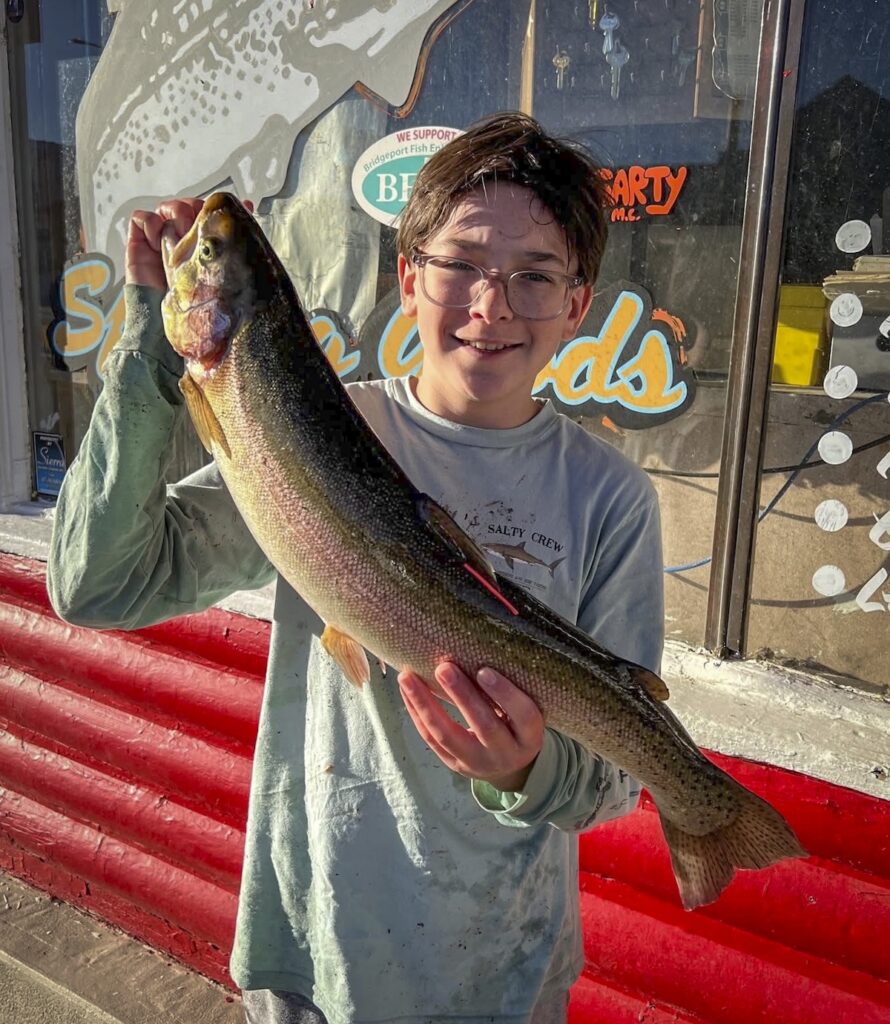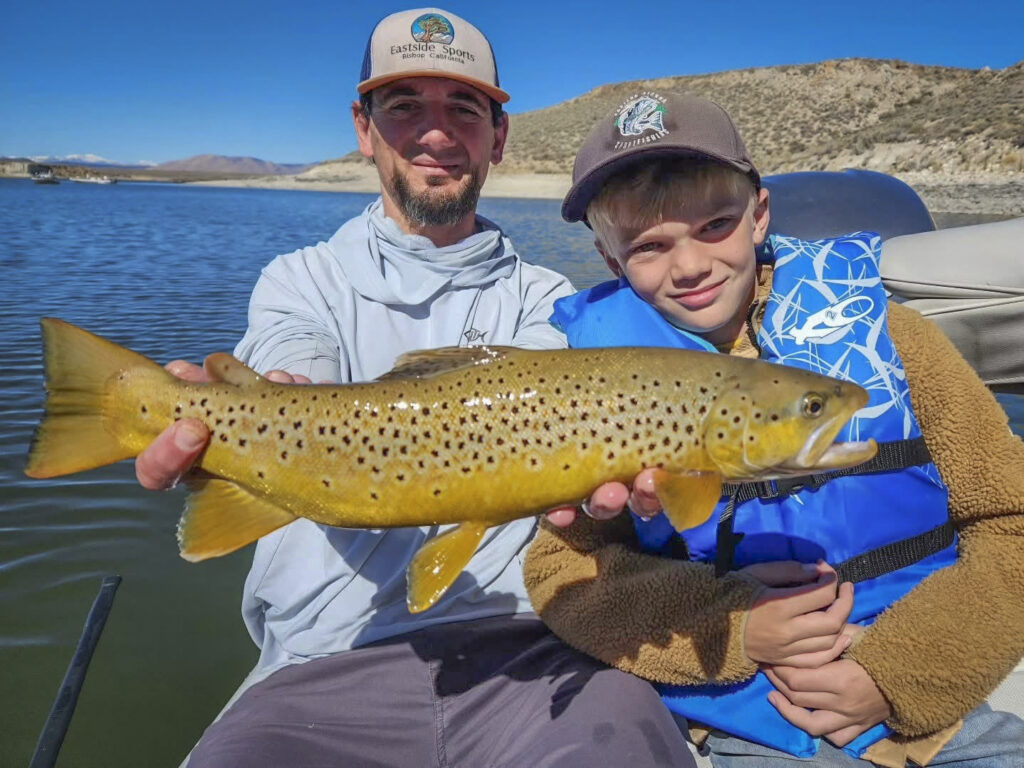
BY ERNIE COWAN
MAMMOTH LAKES—As winter snow begins to accumulate on the peaks of the Eastern Sierra, the general trout season enters its final week which for many trout hunters is as exciting as opening day.
Historically, some of the biggest trout of the season are reeled in during those last few days of the season, and you can bet there are many anglers lurking at prime waters armed with special techniques, lures and baits with high hopes of landing that new personal best rainbow or brown, or maybe, just maybe even a new state record fish.
It’s also a favorite time, because, unlike the opener, there is hardly any competition on Eastern Sierra waters.
Most landings and waterfront services are closed now, but if anglers can get there, waters are still open until the sun goes down on Nov. 15.
For all those good folks who manned the landings, boat rentals and tackle shops, it’s now grunt time as docks are removed for winter, water lines are turned off, and buildings are boarded up before snows arrive.
It might get a bit chilly as Nov. 15 approaches, but it will be peaceful and quiet, maybe a curious bear to two still looking for a trout meal, but overall, a wonderful time to enjoy the High Sierra before the winter slumber.
At press time, WON didn’t find any monster fish to report, but anglers agreed that the bite has been quite active as cooler waters have spread trout out, bringing fish closer to shore as they feed aggressively before lakes ice over.

While we saw a lot of 2- to 4-pound fish, a few larger ones were checked in, including a 6.56-pound rainbow from Bridgeport Reservoir, caught by Kirk Pasley, and a 5.75-pound Robinson Creek rainbow landed by Bridgeport local Jordan Martinez.
So far, those anxiously awaited monster browns have remained elusive at Bridgeport’s Twin Lakes. We did hear about a 4.5-pound brown that caught and released at Lower Twin, and you can expect increased fishing pressure during the season’s final week.
Crowley Lake was also producing some larger cutthroats and browns to 22 inches, with cooler water spreading fish out in many areas.
While longer range reports show some heavy weather headed to Eastern Sierra later in November, it looks like anglers enjoying the early days of winter fishing should not have to battle deep snow.
On Nov. 16, regulations change with a few areas remaining open to winter fishing. Anglers should check regulations closely, since many areas open to winter fishing are limited to artificial, barbless and unscented lures or flies and a zero limit, meaning catch-and-release only.
The most popular winter fishing spots include the Lower Owens River, including the Wild Trout Section, Pleasant Valley Reservoir, the Upper Owens River above Crowley Lake and Hot Creek.

The East Walker River, once a prime winter fishing venue, remains closed to winter fishing, but other area waters open include the West Walker River, Robinson Creek, Green Creek, Virginia Creek, Buckeye Creek, Little Walker River, Rock Creek, McGee Creek (upstream from US 395), Lee Vining Creek (From the Lee Vining conduit upstream.)
Additionally, lakes not considered resort lakes that have landings are also open, but ice and deep winter snow make them challenging at least, and impossible at best to reach.
While the first few weeks of winter fishing might seem like just an extension of the general trout season, once winter sets in, things change, requiring different equipment, tactics and strategy.
Often, the biggest issue is the weather. Winter temperatures can dip below freezing, and deep snow means the only access is a difficult hike or snowmobile trip.
Snow-covered roads that summer anglers have used many times can become impassable mud bogs, and the towing fee for being pulled out is staggering.
Days are shorter, and fish often don’t become active until mid-morning or later, so fishing windows are very narrow.
Winter fish are often not feeding, making fly or lure selection critical, not to mention locating the fish and making a perfect presentation.
Winter trout are often lurking in the deepest holes, where water temperatures might be just a bit warmer.
All of this might make you wonder, why would I go winter fishing?
But the rewards are enormous.
The scenery can be glorious.
Imagine a picturesque Sierra Landscape covered in a fresh blanket of untracked snow?
You may have water all to yourself, especially during the week.
And then there’s the initial vibration then the slam of a winter trout that can make the cold go away as your heart beats faster.
It’s “game on!”
It’s a unique kind of fishing for those who love the High Country and these challenges and rewards that come with it only add to the things that make this such a special place.
Let’s take a look at current conditions from Bishop to Bridgeport and see what the High Country has to offer late season anglers.
Bishop area waters and Lower Owens River—It’s become routine now for Bishop Canyon waters to be stocked with both DFW and trophy rainbows right up until the end of the general season. This means anglers can expect some larger fish to show up in the final week of the season but also look forward to next season’s April opener since those brutes will still be there.
North Lake could quickly become difficult to reach if a storm hits in the next week, but Lake Sabrina and South Lake should be accessible until the season closes.
Flows in the forks of Bishop Creek are down to ideal levels and the deeper pools should be holding some nice fish.
Flows on the Lower Owens are also down to ideal levels for wading and there are some larger browns being caught south of Big Pine. Daytime temperatures on the Lower O are also much more comfortable, and the pesky mosquitos are fewer in numbers.

Rock Creek, Convict, Crowley and Mammoth Lakes area—Services in Rock Creek Canyon are all closed for the season, but the lake is well stocked and until storms hit, anglers can expect some non-stop action at backcountry lakes for wild rainbows, brown and brookies that are not particular about what they bite.
Convict Lake Marina remains open until Nov. 15 with rental boats available. The lake has been stocked weekly with DFW hatchery trout and has also received trophy rainbows. The inlet is always a hot spot, but cooler water now has fish moving closer to shore to feed. The Ambush at the Lake derby continues at Convict Lake until Nov. 15.
Services at Crowley Lake are now closed, but the lake is open to anglers until Nov. 15. Cutthroats and some larger browns have been biting on midge patterns. Anglers are limited to barbless, unscented artificials only and a daily limit of two trout, 18 inches or larger.
Snow at any time could close access to Mammoth Basin Lakes, and while services are closed, waters remain open to fishing until the season ends. These lakes sit at higher elevations, so be prepared for sudden changes in weather and colder temperatures. Lakes are well stocked with trophy rainbows.
June Lakes, Lee Vining, Lundy Lake—All landings in June Loop are now closed for the season and Rush Creek is closed to fishing. Fishing is open the Loop until Nov. 15. Not many reports since landings are closed, but some browns are being caught at the back end of Grant Lake were Rush Creek flows in, and there are reports of a few cutthroats at June Lake.
No report from Lundy Lake but Lee Vining Creek continues to produce some bigger rainbows now that flows are down to fishable levels.
Virginia Lakes, Bridgeport area—Services at Virginia Lakes are closed, but anglers are reporting good action for 2 to 4-pound-plus rainbows. This is a higher elevation lake, so be prepared for storms and cold.
Fishing at Bridgeport Reservoir has been mixed, but some larger trout are biting for trollers and the shore fishing near the Bathtub has picked up.
The Landings at both Upper and Lower Twin lakes have closed for the season, but there are reports of some 4-pound-plus browns being caught as late season anglers hope for those larger double-digit trophy fish to get hungry.
As a veteran of more than 40 Sierra seasons, it seems like they are flying by faster and faster.
This was good year. The communities of the Eastern Sierra have figured it out and the programs of stocking trophy rainbows are paying off as even veteran anglers are hooking into some new personal best fish.
The Eastern Sierra is a special place, and once you’ve been there, you will always want to go back.
If you don’t make it up for winter fishing, WON look forward to seeing you for next season.



